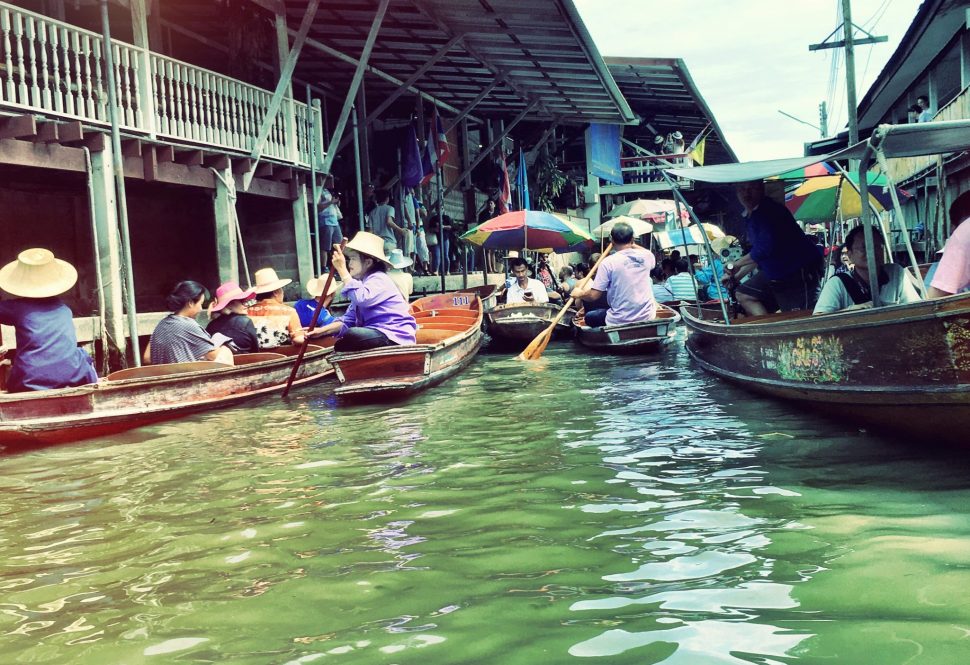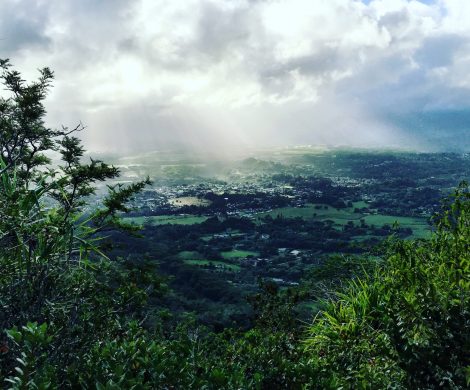
Boats have been used for thousands of years to deliver food and other agricultural products from the farm to the consumers. Cities in ancient Europe flourished with trade movement along canals and rivers by boat. Before the advent of trucks, refrigerated warehouses, and grocery stores, people frequently greeted their food providers at the dock to negotiate on their daily sustenance.
In one part of the world, people still do. Ratchaburi province in Western Thailand, about 80 km from Bangkok is home to one of the world’s oldest Floating Markets in Damnoen Saduak. Floating markets have historically been the principle means of commerce between villages and riverside communities like those along the basin of the Chao Phraya River. Canals were dug out to aid in the transport of goods from one community to another. Farmers paddle their produce in wooden canoes from the fields outside the city to the crowded markets along these ancient canals.
Imagine shopping for fruit, meat, water, donuts, souvenirs, clothing, hats or anything that you might find in a typical travel destination filled with shops and locals catering to tourists visiting their country for the first time. Except now imagine doing the shopping and eating on a painted long tail boat with other little boats all around you.
Welcome to the floating market!
Today the Damnoen Saduak floating market is one of the most popular tourist destinations in Thailand. From everything I have heard it has lost much of its charm as an authentic floating market catering to the locals and has turned into a commercial tourist trap.
Nevertheless, it had been on my bucket list for a while, and during my last trip to Bangkok, I had a Saturday morning free and decided not to waste it. I happened to be in Bangkok over the weekend of Vesak Day, the commemoration of the birth of the Buddha, which fell on a Friday. Most Thai friends were away for the long weekend.

An Egyptian friend who lives in Bangkok also had nothing to do that Saturday. So, the two of us took a private taxi for 2000 Baht and left Bangkok at 6.30 AM on Saturday morning with the aim of avoiding city traffic as well as the horde of tourist buses that would descend upon the floating market after 9 am.
As we started on our way, our driver asked us if we had been to the railway market yet. Many of you may have seen the viral video on Facebook where a train slowly makes its way through a narrow strip of a market, dangerously close to the stalls lining both sides of the tracks. It turns out, the Maeklong Railway Market was on the way to the Damnoen Saduak floating market and the first train of the day (there are four crossings a day) was at 8:30 am!
For an additional 500 Baht, our driver was willing to make that detour. Off we went cruising through the unusually empty streets of Bangkok, passing by the salt fields on the outskirts of the city to our first stop in Samut Songkhram. It took us just about an hour to get there, which gave us 45 minutes to explore the market before the train would pass through.
Maeklong Railway Market
The Maeklong Railway market looks like any other busy, bustling open-air market in South East Asia. The only difference— a fully functional railway track runs right through the market. Locals weave their way around vendors shopping for fruits, vegetables, fresh seafood, herbs and spices and other local foods, walking on the train track like they are on a regular street!
Display tables are piled high with brightly colored tropical fruits and vegetables such as lychee, durian, and mango. The ‘aroma’ of fresh seafood on ice — a variety of fish, shrimp, snails and things I couldn’t identify— hit my olfactory senses almost making me gag, as we jostled past the crowd of locals and tourists.
The market is sheltered by low-hanging awnings and umbrellas and all the display tables in the stalls have wheels underneath.
At 8:25 a piercing siren sounds and in a flash the market transforms! One moment the tracks are completely covered by people and produce, and in the next 2-3 minutes, almost in a synchronized performance, people step away from the track, vendors scoop up their boxes, baskets and anything else that is on the track, wheel back the display tables of their stalls and pull back the awnings and umbrellas, holding on to the poles supporting them, to make way for the train to pass.
It is such a tight squeeze that the train traveling at about 15mph almost touches the fruits, vegetables and everything else at the marketplace as it passes through. In less than a minute, the train has passed through the market to the station on the other side. The awnings go back in place, display tables wheeled forward, shoppers are back on the track picking up the haggling they left off just minutes earlier, as though nothing happened.
It’s almost surreal how the market comes to a complete standstill in a matter of minutes, and after a brief interlude of maybe less than a minute as the train passes through, everything goes right back to normal.
It’s not surprising considering how long they’ve been doing this. The railway was set up in 1905, the market has been here for generations before that.
Adapt, adjust, accommodate!
Thais call this place Talad Rom Hoop Market which literally translates to “Market Umbrella Pulldown”. Watch the video and you’ll see why!
Damnoen Saduak Floating Market
From the Railway Market, the floating market in Damoen Saduak is only 20 minutes away. I was worried about the tour bus crowds and the resulting infamous boat traffic jams in the canals, but luckily we got there before the buses and arrived at what seemed like a fairly empty dock.
I had read that there were many tourist scams with boats charging atrocious rates for a tour of the floating market. But now the government has stepped in and standardized the fees. You have the option of taking a boat for 1 hour, 90 minutes or 2 hours. Since it was just the two of us and we didn’t plan on shopping; we were just there to enjoy the experience, we chose the 1 hour option at 2000 Baht. We prepaid at the dock and got a ticket and were led to spot where a number of long tail boats were ‘parked’.
Our boatman took us through the narrow canal lined by greenery and rural Thai homes and suddenly it opened up into a larger waterway with a welcoming arch to the floating market. We were surprised to see that it seemed largely empty.
The boatman went through a labyrinth of canals and each time we passed a vendor in a straw hat ‘paddling’ (see what I did there!) her wares he would slow down, allowing us to take pictures. We soonrealizedd that we were in the ‘residential’ part of the market. This is where the farmers and other vendors probably lived and life was slowly stirring on a Saturday morning. We passed by old women cooking breakfast on their boat and selling it to the residents waiting on their front ‘porch’.

I found it interesting that most of the boat vendors were women, primarily older Thai women wearing straw hats, with obviously extraordinary arm strength!
After about 20 minutes of floating by in the relatively empty residential area, the boatman turned into yet another canal and suddenly we were hit full in the face by a riot of noise, colors, people and smells! So, that’s where the tourists were hiding.
Vendors selling fresh coconuts, roasted chicken, souvenirs and stir-fry float by as you cruise through the market. Shops on stilts sell everything from hats to hand painted porcelain. We bought a fresh coconut each to sip on and get some respite from the stifling heat.
Most of the vendors don’t speak English, but the only language you need is the one on the calculator, which they use generously to show you the price of something. Tourists obviously get quoted inflated prices and it helps if you go with a local. My Egyptian friend speaks some Thai and that impressed our boatman enough that each time we wanted to dock at a shop, he warned the shopkeeper that she was a local! I wasn’t really planning on buying anything, but a hanging lantern made of coconut shells, and a set of Benjarong hand painted teacups caught my eye and I couldn’t resist.
If you have been to a Chinatown almost anywhere in the world, then imagine the bustling, frenetic pace of a Chinatown on water, and you have the floating market.
This is a great place to have breakfast if you are not a vegetarian like me. We were surrounded by food vendors preparing piping hot bowls of noodles, cooking fried rice, and frying spring rolls on their boats. They give you Styrofoam bowls and plastic cutlery so you can keep exploring the market as you enjoy your brunch.
It was almost 11 AM by now and the hordes had descended. We did get caught in a boat traffic jam and it’s quite an experience to see how the boatmen/women and vendors masterfully maneuver their way around each other calmly while simultaneously conducting business!
It was time to head back to ground and be on our way back to Bangkok. As we arrived at the dock, we found it completely overrun with people. I was so glad we got there early and took a private taxi instead of a tour group, which allowed us to have a more authentic experience at a relaxed pace.
As we came off the boat, our driver wanted to know if we would like to make a quick stop at the Elephant village nearby before heading back. It was only 11 AM and I didn’t need to be back in Bangkok till 2 PM.
Elephant Village
I grew up in India where Elephants are common. Most major Hindu temples have a resident elephant that blesses you with its trunk in return for a banana. I have been on a number of elephant rides as a child, but its been a while since I was on one of these majestic beasts as an adult. Since we had time to kill, we decided to go on an elephant ride.
For 600 baht per person, you get to enjoy a 25-minute elephant ride on a predetermined path through the forest, which also includes a short walk across a pond.
You climb onto a small wooden fort and wait in line for your turn to get on the elephant. I was amused to see a statue of the elephant God Ganesha in the fort.
Our elephant was a friendly fellow named Lucky. We stepped on the seat strapped on to Lucky’s back secured only by a tattered fabric ‘seat belt’. The mahout (the elephant rider) patted Lucky’s forehead and spoke to him and he was off. I had forgotten how bumpy an elephant ride can be. It’s like swaying on a ship! If you are the type that gets sea sick or has motion sickness, I would not recommend an elephant ride.
The forest is green and ripe with the smell of elephant poop! There is a small pond crossing, which I suspect is man-made as a novelty factor for tourists. Lucky expertly walked through the clearly poop-filled pond and the water came up to his shoulder, so there was no danger of us getting soaked.
At a particular spot, the mahout climbed off Lucky and asked if we wanted pictures. I handed him my phone, and Lucky decided he wanted a snack break as he reached into some trees. The Mahout spoke to him gently and Lucky raised his trunk and brought it back for us to pet, which initially we didn’t understand. But he kept reaching back which was alarming and I soon realized we were supposed to lean over and pet him. Once we petted him, and the pictures were taken, he happily went back to snacking on his leaves from the trees nearby.
Obviously, the Mahout wanted to be given a tip for this special service and I handed him 100 baht (that’s less than $3 to me, but a significant tip in rural Thailand).
The overall experience is just about average. Maybe because elephants are not a novelty to me, I didn’t find it to be that big a deal compared to a lot of other excited tourists who lined up for their ride.
If you have never been on an elephant before and just want a short, uneventful ride to appease your curiosity, then this is something you may enjoy. I was also wondering how they treat their elephants, since I have read about rampant elephant abuse in many places. I can only base my views on what I saw of Lucky’s interaction with his mahout in that 25-minute ride. The mahout was gentle and spoke to him like he would to a child. Lucky looked well looked after, but obviously I am no expert.
In any case, if you like elephants, I would recommend visiting the elephant sanctuary in Chiang Mai which is a rescue and rehab centre for elephants.
If you have half a day in Bangkok and don’t fancy going to the mall, then this is my recommended itinerary:
Book a private taxi, get an early start (around 6:30 am) and start with the Mae Klong Railway market to watch the first train pass through. Then head to Damoen Saduak Floating Market. Finish off with the elephant ride, if you’ve never done one of these before and you will be back in Bangkok in time for lunch!














































